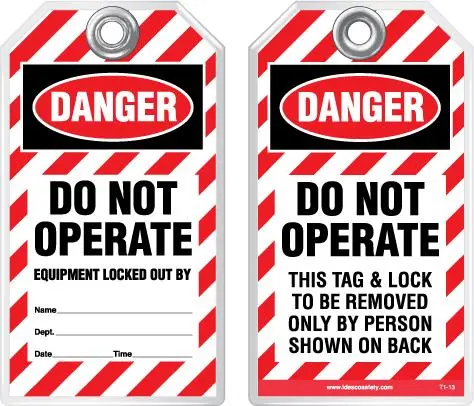OSHA 1910.147 Explained

OSHA 1910.147 outlines lockout/tagout procedures to prevent accidental machine start-up during maintenance. It protects workers from hazardous energy, ensuring safety and compliance in industrial environments.
What is "OSHA 1910.147"?
OSHA 1910.147 outlines the lockout/tagout (LOTO) standard established by the Occupational Safety and Health Administration to protect workers from hazardous energy during servicing and maintenance of machines and equipment.
✅ Requires lockout/tagout devices to prevent unexpected energy release
✅ Protects employees from serious injury during maintenance
✅ Mandates training and periodic inspections for compliance
This regulation applies to general industry and ensures that proper procedures, training, and devices are used to control unexpected start-up or release of stored energy.
Request a Free Training Quotation
Why is it Important?
Workers who perform servicing or maintenance on energized parts are at risk of encountering electrical, mechanical, hydraulic, pneumatic, chemical, thermal, or other forms of energy. These energy sources can present potentially hazardous energy that may result in injury if not properly controlled.
Employers must implement lockout/tagout procedures, which involve the use of energy isolating devices and lockout or tagout devices to control hazardous energy. Proper procedures prevent the unintended startup of machines or release of energy that could injure workers. For general information about OSHA Lockout Tagout, visit our main page.
Who Must Comply?
Compliance with OSHA 1910.147 applies to any employer whose workers perform servicing or maintenance on equipment or machinery. This includes employees in power generation, transmission, and distribution industries, where workers regularly encounter controlled hazardous energy. Employees who attempt to control hazardous energy must be trained in proper lockout/tagout procedures to minimize the risks associated with these energy sources. To meet OSHA compliance requirements under the 1910.147 standard, employers must implement a written energy control program that clearly outlines procedures for controlling hazardous energy. This program must address how to identify stored energy hazards, specify detailed isolation procedures, and define roles for both authorized employees—those trained to apply lockout/tagout devices—and affected employees—those who operate or work near the equipment being serviced. Ensuring that all personnel understand their responsibilities is key to preventing accidental energization during maintenance.
An effective program also includes strict verification of energy control before any servicing or maintenance begins. This means checking that the machinery is fully de-energized and isolated from its energy source before work starts. OSHA’s safety standards for servicing equipment emphasize the need for consistent training, documentation, and supervision to protect workers from serious injuries. A well-enforced lockout/tagout plan reinforces your facility’s commitment to OSHA compliance and creates a safer environment for everyone involved.
See also: What Is the Relationship Between OSHA and NFPA 70E?
What Are Lockout and Tagout Procedures Under OSHA 1910.147?
Lockout and tagout procedures are crucial elements in controlling hazardous energy. Lockout devices are physical devices that prevent the unexpected energization of equipment by isolating energy sources. They are placed on energy-isolating devices, such as circuit breakers, valves, or switches, to prevent the machines from starting up.
Tagout devices, while less physically restrictive, involve placing a warning tag on energy-isolating devices to signal that the equipment should not be energized. Although less secure than lockout devices, tagout procedures are important in warning workers of potential hazards.
Both methods ensure that the method or release of stored energy is safely controlled, reducing the risk of injury to workers performing maintenance or servicing.
What Types of Energy Sources Does OSHA 1910.147 Cover?
The standard covers a wide range of hazardous energy sources, including electrical, mechanical, hydraulic, pneumatic, chemical, thermal, and other types of energy. The regulation ensures that all energy types are addressed in energy control procedures. This includes both the primary energy sources and any stored or residual energy that could still pose a risk even after the equipment is de-energized.
For instance, a piece of hydraulic pressure equipment could retain stored energy even after the machine is turned off. To ensure safety, energy control procedures must account for these hazards and the type and magnitude of energy that could be encountered.
What Training is Required Under OSHA 1910.147?
Electrical safety training is a fundamental part of OSHA 1910.147 compliance. Workers who are involved in lockout/tagout procedures must receive comprehensive training on controlling hazardous energy. This includes understanding the types of energy sources they may encounter, such as electrical, mechanical, hydraulic, pneumatic, chemical, or thermal energy. Start here: OSHA Electrical Safety Training
Workers must also be trained on the proper use of lockout tagout devices to ensure they can safely manage potentially hazardous energy. Training should also include instruction on identifying energy sources, how to isolate and lock them out, and procedures for verifying that the energy is effectively controlled before performing servicing or maintenance.
Periodic re-training is also required to ensure workers remain knowledgeable and comply with the latest safety protocols. This is especially important when changes are made to the equipment or energy control procedures. See our Electricity Forum Lockout Tagout Training course page, for more details.
Related Articles:
Explore our Arc Flash Training Programs or contact us to Request a Free Training Quotation for group safety sessions and PPE consultation.
On-Site Training
Interested in cost effective, professional on-site electrical training?
We can present an Electrical Training Course to your electrical engineering and maintenance staff, on your premises, tailored to your specific equipment and requirements. Click on the link below to request a Free quotation.
EF PARTNER MEDIA
Product Showcases
Shared Media
















